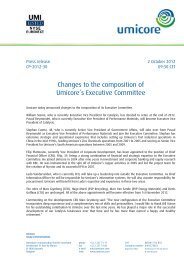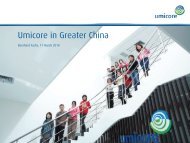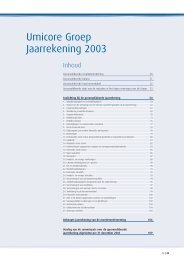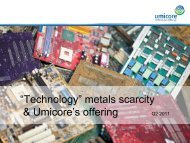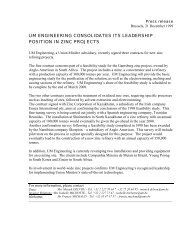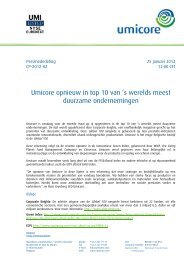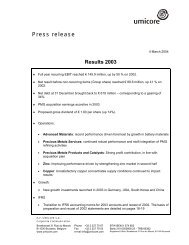No Slide Title - Umicore
No Slide Title - Umicore
No Slide Title - Umicore
You also want an ePaper? Increase the reach of your titles
YUMPU automatically turns print PDFs into web optimized ePapers that Google loves.
Key developments in<br />
Rechargeable<br />
Battery<br />
Materials<br />
Capital Markets Event<br />
Seoul, 24 May 2012
What is a Li-ion battery?<br />
2<br />
separator<br />
anode<br />
separator<br />
cathode<br />
Anode (= negative)<br />
•<br />
Separator<br />
•<br />
Graphite/carbon<br />
Ion permeable inert membrane<br />
Cathode (= positive)<br />
•<br />
Lithium cobaltite, NMC or LFP as cathode material<br />
Electrolyte<br />
•<br />
Liquid or gel<br />
Charge: Li-ions from cathode to anode<br />
Discharge : Li-ions from anode to cathode
Li-Ion Batteries for electronics<br />
Cathode content<br />
3<br />
10-15 g 50-80 g<br />
15g<br />
10-15 g 50-80 g<br />
100 g
Li-Ion Batteries for automotive<br />
Cathode content<br />
4<br />
HEV<br />
~5 kg<br />
~50 g<br />
PHEV & BEV<br />
~40 kg
Li-Ion Batteries for stationary<br />
Cathode content<br />
5<br />
a couple of tonnes
End user market developments<br />
trigger fast material evolution<br />
6
Cathode material -<br />
7<br />
Micron-size mixed metal oxides,<br />
hydroxides, carbonates,…<br />
(precursors)<br />
Technology development<br />
Precursor Product<br />
Application<br />
Nano to micron-size Lithium mixed<br />
metal oxides, phosphate,..<br />
(cathode materials)<br />
Li-ion polymer cell for validation of<br />
electric & safety performance for<br />
energy and power applications
Where is <strong>Umicore</strong> in the value chain ?<br />
supply metal product application market<br />
Co residues<br />
Recycling & intermediates<br />
Ni residues<br />
8<br />
Co<br />
Ni<br />
LCO<br />
NMC<br />
Li-ion Li ion rechargeable batteries<br />
Portable electronics<br />
Power tools<br />
(P)HEV (P)HEV / / EV<br />
EV<br />
E-bikes bikes<br />
Stationary power
Olen<br />
Hoboken<br />
Engis<br />
<strong>Umicore</strong>’s global business presence<br />
in rechargeable batteries<br />
• Co intermediates production<br />
• Group R&D<br />
• Battery recycling<br />
• beLife (49% JV)<br />
• Industrial Pilot line LFP<br />
Hanau<br />
• Automotive test centre<br />
• HEV testing<br />
9<br />
Belgium<br />
Belgium<br />
Belgium<br />
Germany<br />
• Battery dismantling centre<br />
Maxton<br />
USA<br />
• Battery dismantling centre<br />
Total workforce<br />
> 800 people<br />
Research & development in Europe and Asia<br />
Cheonan<br />
Kobe<br />
Jiangmen<br />
Korea<br />
• Li-ion cathode production<br />
• Research & technology<br />
centre<br />
• Application lab<br />
Japan<br />
• Li-ion cathode production<br />
• Application lab<br />
China<br />
• JUC (70% JV)<br />
• Li-ion cathode production<br />
• JCU (40% JV)<br />
• NiMH cathode production
Overview of Li-ion cathode material technologies<br />
LCO<br />
lithium cobaltite<br />
LiCoO 2<br />
LMO<br />
lithium manganese oxide<br />
LiMnO 2<br />
NMC<br />
nickel manganese cobalt<br />
Li(NixMnyCo1-x-y)O2 LFP<br />
lithium iron phosphate<br />
LiFePO 4<br />
10<br />
Energy Power Safety* Life Cost<br />
+++ +++ - ++ +<br />
- +++ ++ - ++<br />
++ ++ ++ +++ +++<br />
+ +++ +++ ++ ++<br />
* Impacts battery package design
Overview of Li-ion cathode material technologies<br />
Best fit for portable electronics<br />
LCO<br />
lithium cobaltite<br />
LiCoO 2<br />
LMO<br />
lithium manganese oxide<br />
LiMnO 2<br />
NMC<br />
nickel manganese cobalt<br />
Li(NixMnyCo1-x-y)O2 LFP<br />
lithium iron phosphate<br />
LiFePO 4<br />
11<br />
Energy Power Safety Life Cost<br />
+++ +++ - ++ +<br />
- +++ ++ - ++<br />
++ ++ ++ +++ +++<br />
+ +++ +++ ++ ++
Overview of Li-ion cathode material technologies<br />
Best fit for HEVs<br />
LCO<br />
lithium cobaltite<br />
LiCoO 2<br />
LMO<br />
lithium manganese oxide<br />
LiMnO 2<br />
NMC<br />
nickel manganese cobalt<br />
Li(NixMnyCo1-x-y)O2 LFP<br />
lithium iron phosphate<br />
LiFePO 4<br />
12<br />
Energy Power Safety Life Cost<br />
+++ +++ - ++ +<br />
- +++ ++ - ++<br />
++ ++ ++ +++ +++<br />
+ +++ +++ ++ ++
Overview of Li-ion cathode material technologies<br />
Best fit for PHEVs and BEVs<br />
LCO<br />
lithium cobaltite<br />
LiCoO 2<br />
LMO<br />
lithium manganese oxide<br />
LiMnO 2<br />
NMC<br />
nickel manganese cobalt<br />
Li(NixMnyCo1-x-y)O2 LFP<br />
lithium iron phosphate<br />
LiFePO 4<br />
13<br />
Energy Power Safety Life Cost<br />
+++ +++ - ++ +<br />
- +++ ++ - ++<br />
++ ++ ++ +++ +++<br />
+ +++ +++ ++ ++
Overview of Li-ion cathode material technologies<br />
Best choice for energy storage systems<br />
LCO<br />
lithium cobaltite<br />
LiCoO 2<br />
LMO<br />
lithium manganese oxide<br />
LiMnO 2<br />
NMC<br />
nickel manganese cobalt<br />
Li(NixMnyCo1-x-y)O2 LFP<br />
lithium iron phosphate<br />
LiFePO 4<br />
14<br />
Energy Power Safety Life Cost<br />
+++ +++ - ++ +<br />
- +++ ++ - ++<br />
++ ++ ++ +++ +++<br />
+ +++ +++ ++ ++
Application requirements determine<br />
cathode materials used<br />
15<br />
Portable<br />
electronics<br />
Automotive<br />
Energy<br />
Storage<br />
Systems<br />
(ESS)<br />
LCO<br />
NiMH<br />
1995 2005<br />
NMC<br />
LMO<br />
NMC<br />
2010<br />
Other (NaS, …)<br />
LFP<br />
LFP<br />
NMC<br />
2015
<strong>Umicore</strong> well positioned over different materials and<br />
applications, which offers technology and production synergies<br />
16<br />
Portable<br />
electronics<br />
Automotive<br />
Energy<br />
Storage<br />
Systems<br />
(ESS)<br />
LCO<br />
NiMH<br />
1995 2005<br />
NMC<br />
LMO<br />
NMC<br />
2010<br />
Other (NaS, …)<br />
<strong>Umicore</strong> material and application<br />
LFP<br />
LFP<br />
NMC<br />
2015
<strong>Umicore</strong>’s product positioning<br />
Wide multi-chemistry portfolio of advanced cathode materials<br />
17<br />
•<br />
•<br />
•<br />
LCO compounds<br />
NMC and NCA compounds<br />
LFP compounds<br />
> 50% of <strong>Umicore</strong> products on the market for less than 3 years<br />
<strong>Umicore</strong> offers all main cathode materials with peace of mind<br />
for the customer, whatever Li-ion battery application is targeted,<br />
thanks to a strong IP portfolio<br />
•<br />
•<br />
•<br />
<strong>Umicore</strong> owns the concept IP for latest generation LCO suitable<br />
for high-end portable electronics used in high capacity, thin batteries<br />
more capacity<br />
more fun<br />
<strong>Umicore</strong> owns patents on NMC as well as licenses from 3M, offering full freedom to operate<br />
for the different compositions, both for current and future families of products<br />
<strong>Umicore</strong> can now offer LFP with global freedom to operate, in collaboration with Prayon
<strong>Umicore</strong>’s production positioning<br />
Installed production capacity already on industrial scale today<br />
18<br />
•<br />
•<br />
•<br />
•<br />
Track record > 15 years in Li-ion technology<br />
Production synergies from strong position in automotive, portable<br />
electronics, stationary power and power tools<br />
4 production plants, 3 research sites<br />
TS16949, ISO9001, ISO14001 certified<br />
Battery recycling and metals management in closed loop<br />
Leading global supplier of cathode materials<br />
•<br />
•<br />
•<br />
Strong market leadership in high end applications<br />
Serves all key players in the battery industry<br />
> 12 XEV platforms will be on the market<br />
with <strong>Umicore</strong> material in next 1½ years
Electrification of the powertrain requires<br />
batteries of different size and complexity<br />
19<br />
ICE HEV PHEV EV<br />
<strong>No</strong>rmal Start-stop Mild Full<br />
ELECTRIFICATION<br />
Parallel<br />
system<br />
Range<br />
extender<br />
BEV FCEV<br />
Relative<br />
size + + ++ ++ +++ ++<br />
Relative<br />
complexity + ++ +++ ++ ++ ++
Impact of electrification on CO 2<br />
CO 2<br />
Emissions<br />
20<br />
reduction<br />
ICE HEV PHEV EV<br />
<strong>No</strong>rmal Start-stop Mild Full<br />
ELECTRIFICATION<br />
Parallel<br />
system<br />
Range<br />
extender<br />
BEV FCEV
16<br />
14<br />
12<br />
10<br />
8<br />
6<br />
4<br />
2<br />
0<br />
3 scenarios for the electrification of the car<br />
xEV production<br />
The CO2 limits will be reached<br />
through ICE improvement and<br />
xEV introduction<br />
(OEM push only)<br />
21<br />
2011<br />
Scenario 1 Scenario 2 Scenario 3<br />
2012<br />
2015<br />
2020<br />
The CO2 limits will be reached<br />
through xEV introduction<br />
(OEM push only)<br />
2011<br />
[M vehicles]<br />
2012<br />
2015<br />
2020<br />
HEV - NiMH HEV - Li-Ion PHEV - Li-Ion EV - Li-ion<br />
Source: <strong>Umicore</strong> estimate based on external data sources<br />
On top of meeting CO2 limits,<br />
there is also a positive TCO for<br />
consumers<br />
(OEM push + customer pull)<br />
2011<br />
2012<br />
2015<br />
2020
350,000<br />
300,000<br />
250,000<br />
200,000<br />
150,000<br />
100,000<br />
50,000<br />
0<br />
3 scenarios for the electrification of the car<br />
Total Li-ion cathode market per application<br />
The CO2 limits will be reached<br />
through ICE improvement and<br />
xEV introduction<br />
(OEM push only)<br />
22<br />
2011<br />
Scenario 1 Scenario 2 Scenario 3<br />
2012<br />
2015<br />
2020<br />
The CO2 limits will be reached<br />
through xEV introduction<br />
(OEM push only)<br />
2011<br />
2012<br />
[tonnes]<br />
Portable electronics Energy storage systems Transportation<br />
2015<br />
2020<br />
Source: <strong>Umicore</strong> estimate based on external data sources<br />
On top of meeting CO2 limits,<br />
there is also a positive TCO for<br />
consumers<br />
(OEM push + customer pull)<br />
2011<br />
2012<br />
2015<br />
2020
350,000<br />
300,000<br />
250,000<br />
200,000<br />
150,000<br />
100,000<br />
50,000<br />
0<br />
3 scenarios for the electrification of the car<br />
Total Li-ion cathode market per material<br />
The CO2 limits will be reached<br />
through ICE improvement and<br />
xEV introduction<br />
(OEM push only)<br />
23<br />
2011<br />
Scenario 1 Scenario 2 Scenario 3<br />
2012<br />
2015<br />
2020<br />
The CO2 limits will be reached<br />
through xEV introduction<br />
(OEM push only)<br />
2011<br />
2012<br />
[tonnes]<br />
2015<br />
2020<br />
NMC (non-automotive) NMC (automotive)<br />
NCA LCO<br />
LFP LMO<br />
Source: <strong>Umicore</strong> estimate based on external data sources<br />
On top of meeting CO2 limits,<br />
there is also a positive TCO for<br />
consumers<br />
(OEM push + customer pull)<br />
2011<br />
2012<br />
2015<br />
2020
19%<br />
3 scenarios for the electrification of the car<br />
Total cathode materials ratios<br />
7%<br />
24<br />
13%<br />
49%<br />
22%<br />
7%<br />
2%<br />
2020 Scenario 1<br />
11%<br />
27%<br />
[tonnes]<br />
3%<br />
22%<br />
18%<br />
2011<br />
[tonnes]<br />
21%<br />
2020 Scenario 2<br />
13%<br />
22%<br />
[tonnes]<br />
18%<br />
3%<br />
NMC (non-automotive) NMC (automotive)<br />
NCA LCO<br />
LFP LMO<br />
23%<br />
23%<br />
2020 Scenario 3<br />
14%<br />
17%<br />
[tonnes]<br />
14%<br />
3%<br />
29%
How is <strong>Umicore</strong> responding to market dynamics?<br />
Increasing capacity<br />
Developing products within NMC family<br />
for cost and performance<br />
Include LFP in the product offer<br />
25
Continuous expansion of production capacity<br />
and capabilities since start of production<br />
26<br />
<strong>Umicore</strong> Li-ion cathode sales<br />
2000<br />
2005<br />
[tonnages]<br />
2010<br />
2011<br />
<strong>Umicore</strong> figures (estimate for 2012)<br />
2012<br />
Expansion<br />
of Cheonan plant<br />
Recent investments<br />
Greenfield plant<br />
in Kobe
Developing products within NMC family<br />
for cost and performance<br />
Different NMC material generations are being developed<br />
27<br />
•<br />
•<br />
Reducing cost/kg<br />
Increasing kWh/kg<br />
To be introduced in the market in the coming years<br />
NMC<br />
Generation 1<br />
⇒ Reducing cost/kWh<br />
2011-2012 2017 2019-2020<br />
NMC<br />
Generation 2<br />
NMC<br />
Generation 3
Cost/kWh is strongly influenced by<br />
the impact from the metals market<br />
28<br />
$/kg<br />
50<br />
40<br />
30<br />
20<br />
10<br />
0<br />
Metal prices (monthly averages) 2009 - 2011<br />
Ni LME<br />
Co LMB 99.8 LH<br />
Jan/09 May 09 Sep/09 Jan/10 May/10 Sep/10 Jan/11 May/11 Sep/11 Jan/12<br />
Scenario low Scenario high Scenario medium
NMC generation 1<br />
NMC (1:1:1) is the recognized standard<br />
NMC (1:1:1) fulfils current automotive requirements in terms of performance and safety<br />
29<br />
Cellcore ®<br />
MX<br />
NMC (1:1:1)<br />
LiCoO 2<br />
LiNiO 2<br />
LiMnO 2
NMC generation 2<br />
OEMs striving for better cost and/or performance<br />
Two main development paths are co-existing depending on cell design and global region<br />
Higher Ni content<br />
Pushes energy density<br />
30<br />
•<br />
•<br />
⇒<br />
Increase kWh/kg<br />
Maintaining cost/kg<br />
Decreases cost/kWh<br />
Cellcore® MX<br />
NMC (1:1:1)<br />
LiCoO 2<br />
LiNiO 2<br />
Cost/kWh<br />
NMC (1:1:1) 100%<br />
Low Co 75% - 80%<br />
High Ni 75% - 80%<br />
Lower Co content<br />
Reduces metal cost<br />
•<br />
•<br />
⇒<br />
LiMnO 2<br />
Decrease cost/kg<br />
Maintaining kWh/kg<br />
Decreases cost/kWh
NMC generation 3<br />
HLM/HNS could improve cost/kWh by ~40%<br />
The main cost/kWh driver with HLM/HNS is a performance technology breakthrough<br />
to a higher voltage design<br />
LiNiO 2<br />
31<br />
Cellcore ®<br />
Cellcore ®<br />
MX<br />
NMC(1:1:1)<br />
Cellcore ®<br />
HNS<br />
HLM<br />
LiCoO 2<br />
cost/kWh<br />
NMC (1:1:1) 100%<br />
HLM/HNS 60% - 70%<br />
HLM (High Li, high Mn),<br />
HNS (High Ni Spinel)<br />
•<br />
•<br />
⇒<br />
LiMnO 2<br />
Higher kWh performance<br />
Improved metal base<br />
HLM attractive to automotive<br />
applications
Automotive cost/kWh perspective<br />
Long-term reduction of ~40% is possible with NMC<br />
32<br />
Cost/kWh<br />
100%<br />
75%<br />
50%<br />
25%<br />
0%<br />
NMC cost roadmap<br />
Generation 1 Generation 2 Generation 3<br />
NMC (1:1:1) Low Co High Ni HLM HNS<br />
*assumption: all products in mass production volumes
Li-ion battery cost reduction potential<br />
Cathode material has impact on various levers<br />
33<br />
Cost/<br />
kWh<br />
Cost 2010<br />
Impact from<br />
cathode materials<br />
Raw<br />
Materials<br />
Cost reduction levers for battery production<br />
Material<br />
processing<br />
Cell manufacturing<br />
Other<br />
components<br />
Source: Roland Berger, March 2011<br />
Battery<br />
assembly<br />
Increase<br />
specific<br />
energy<br />
+++ +++ + +/- +/- +++<br />
cost/kg cost/kg cost/kg kWh/kg<br />
-60%<br />
Best case<br />
scenario
34<br />
Expanding product portfolio with LFP
35<br />
Combining strengths<br />
Prayon has historical position in phosphate chemicals<br />
•<br />
•<br />
Brings IP<br />
Brings good access to phosphate raw materials<br />
<strong>Umicore</strong> has long track record in rechargeable battery materials<br />
•<br />
•<br />
•<br />
Brings IP<br />
Brings process upscaling knowhow<br />
Brings customer intimacy and marketing capabilities<br />
Industrial pilot plant in Engis, Belgium<br />
•<br />
•<br />
•<br />
•<br />
100 tonnes/year capacity<br />
Focus on process optimisation and product development<br />
Start commissioning in July 2012<br />
Products will be marketed by <strong>Umicore</strong>
Full service model with battery recycling services<br />
36<br />
Metals<br />
EOL<br />
LIBs<br />
LCO NMC<br />
NCA LFP<br />
Chemistry<br />
material<br />
Material science<br />
solutions<br />
Metallurgy<br />
Cathode<br />
slurries<br />
Application<br />
know-how<br />
Recycling<br />
Off-spec<br />
powders<br />
Material<br />
solutions<br />
Electrodes<br />
Straightforward<br />
•<br />
•<br />
•<br />
Partner remains owner<br />
Metal balance account<br />
One processing fee
Conclusions<br />
Li-ion battery application is growing rapidly thanks to fast product turnover in<br />
portable electronics and penetration in new sizeable applications (automotive and<br />
energy storage systems)<br />
End-user requirements drive cathode material development<br />
<strong>Umicore</strong> has a leading position as cathode material maker today and has the<br />
broadest product portfolio covering the materials of choice for all current and future<br />
applications of Li-ion batteries<br />
<strong>Umicore</strong> can offer significant synergies, both from a technology development point<br />
of view, with its broad material coverage, as from a production setup, covering all<br />
main applications<br />
37
Forward-looking statements<br />
This presentation contains forward-looking information that involves risks and uncertainties,<br />
including statements about <strong>Umicore</strong>’s plans, objectives, expectations and intentions.<br />
Readers are cautioned that forward-looking statements include known and unknown risks<br />
and are subject to significant business, economic and competitive uncertainties and<br />
contingencies, many of which are beyond the control of <strong>Umicore</strong>.<br />
Should one or more of these risks, uncertainties or contingencies materialize, or should any<br />
underlying assumptions prove incorrect, actual results could vary materially from those<br />
anticipated, expected, estimated or projected.<br />
As a result, neither <strong>Umicore</strong> nor any other person assumes any responsibility for the<br />
accuracy of these forward-looking statements.<br />
38
The presenter<br />
Kurt Vandeputte<br />
VP Rechargeable Battery Materials<br />
39<br />
Kurt holds a PhD in Chemistry and started his professional<br />
career in 1997 with <strong>Umicore</strong>. After a five year operational<br />
assignment at the <strong>Umicore</strong> Olen plant he joined the Cobalt &<br />
Specialty Materials Business Unit in a technology development<br />
function. From 2006 to 2008 he was responsible for Sales &<br />
Marketing in the Rechargeable Battery Materials business line<br />
and took overall responsibility for this business line in March<br />
2008. In January 2012, when Rechargeable Battery Materials<br />
became a separate business unit, Kurt was appointed VP.



